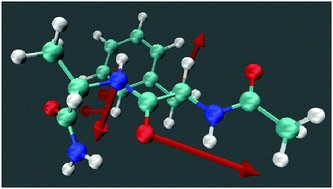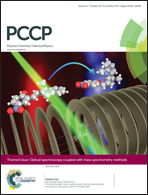Vibrational mode assignment of finite temperature infrared spectra using the AMOEBA polarizable force field†
Abstract
The calculation of infrared spectra by molecular dynamics simulations based on the AMOEBA polarizable force field has recently been demonstrated [Semrouni et al., J. Chem. Theory Comput., 2014, 10, 3190]. While this approach allows access to temperature and anharmonicity effects, band assignment requires additional tools, which we describe in this paper. The Driven Molecular Dynamics approach, originally developed by Bowman, Kaledin et al. [Bowman et al. J. Chem. Phys., 2003, 119, 646, Kaledin et al. J. Chem. Phys., 2004, 121, 5646] has been adapted and associated with AMOEBA. Its advantages and limitations are described. The IR spectrum of the Ac-Phe-Ala-NH2 model peptide is analyzed in detail. In addition to differentiation of conformations by reproducing frequency shifts due to non-covalent interactions, DMD allows visualizing the temperature-dependent vibrational modes.

- This article is part of the themed collection: Optical spectroscopy coupled with mass spectrometry methods

 Please wait while we load your content...
Please wait while we load your content...